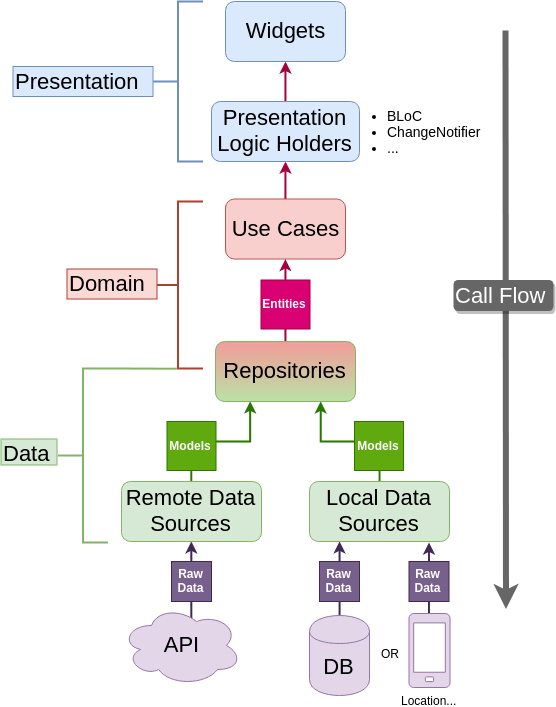Flutter — Clean Architecture:
Clean Architecture is a software design principle that promotes the separation of concerns and aims to create a modular, scalable, and testable codebase. It is not specific to Flutter but can be applied to any software development framework. Clean Architecture provides guidelines on how to structure the codebase and define dependencies between different layers of an application.
In the context of Flutter, Clean Architecture typically consists of the following layers:
- Presentation Layer (UI): This layer contains the user interface components, such as widgets, screens, and views. It is responsible for handling user interactions and rendering the UI. The presentation layer should be independent of the business logic and data access implementation details.
- Domain Layer (Business Logic): The domain layer represents the core business logic of the application. It contains use cases, entities, and business rules. Use cases define the operations or actions that can be performed in the application. Entities represent the essential objects in the domain and encapsulate their behavior and state. The domain layer should be agnostic of any specific framework or technology.
- Data Layer: The data layer is responsible for data retrieval and storage. It consists of repositories and data sources. Repositories provide an abstraction layer for accessing and manipulating data. They define the contract or interface for data operations, which are implemented by the data sources. Data sources can be remote APIs, local databases, or other external data providers. The data layer shields the domain layer from the details of data storage and retrieval.
Guidelines for Dependencies Between Layers:
The Clean Architecture principles suggest the following guidelines for dependencies between layers:
- The Presentation layer depends on the Domain layer: The presentation layer interacts with the domain layer through interfaces or abstractions provided by the domain layer. This allows the business logic to be decoupled from the presentation layer.
- The Domain layer is independent of other layers: The domain layer contains the core business logic and should not have any dependencies on external frameworks, libraries, or UI-related components. This makes the domain layer reusable and platform-agnostic.
- The Data layer depends on the Domain layer: The data layer implements the interfaces or abstractions defined in the domain layer. This allows different data sources (e.g., APIs, databases) to be plugged into the application without affecting the domain layer.
Benefits of Clean Architecture:
By adhering to Clean Architecture principles in Flutter, you can achieve benefits such as:
- Separation of concerns: The codebase becomes modular and easier to maintain, as each layer has distinct responsibilities.
- Testability: The layers can be tested independently, making it easier to write unit tests and integration tests for the business logic and data layer.
- Scalability and maintainability: The clean separation of layers allows for easier modifications and additions to the codebase as the application grows.
To implement Clean Architecture in Flutter, you can organize your codebase using packages or folders for each layer and enforce the dependency flow from the presentation layer to the domain layer and then to the data layer. Various architectural patterns like BLoC (Business Logic Component), Provider, or Riverpod can be used in combination with Clean Architecture principles to implement the interactions between layers and handle state management in Flutter applications.

Code Example:
Certainly! Here’s an example of how you can structure a Flutter application using Clean Architecture principles:
- Presentation Layer (UI):
- Create a `screens` folder to hold the different screens or pages of your application.
- Use Flutter’s widget tree to define the UI components, such as `Scaffold`, `AppBar`, `ListView`, etc.
- Handle user interactions using callbacks or event-driven architectures like BLoC or Provider.
// screens/home_screen.dart
import 'package:flutter/material.dart';
class HomeScreen extends StatelessWidget {
@override
Widget build(BuildContext context) {
return Scaffold(
appBar: AppBar(
title: Text('Home'),
),
body: ListView(
children: <Widget>[
// Widgets for displaying data or capturing user input
],
),
);
}
}2. Domain Layer (Business Logic):
- Create a `domain` folder to hold the domain-specific classes.
- Define entities that represent the core objects in your application.
- Implement use cases, which encapsulate the business logic and interact with repositories.
// domain/entities/user.dart
class User {
final String id;
final String name;
final String email;
User({required this.id, required this.name, required this.email});
}
// domain/usecases/get_users_usecase.dart
import 'package:your_app/domain/entities/user.dart';
import 'package:your_app/domain/repositories/user_repository.dart';
class GetUsersUseCase {
final UserRepository userRepository;
GetUsersUseCase(this.userRepository);
Future<List<User>> execute() {
return userRepository.getUsers();
}
}3. Data Layer:
- Create a `data` folder to hold the data-related classes.
- Define a `repositories` folder for the repository interfaces.
- Implement data sources that interact with external services or databases.
// data/repositories/user_repository_impl.dart
import 'package:your_app/data/datasources/user_data_source.dart';
import 'package:your_app/domain/entities/user.dart';
import 'package:your_app/domain/repositories/user_repository.dart';
class UserRepositoryImpl implements UserRepository {
final UserDataSource userDataSource;
UserRepositoryImpl(this.userDataSource);
@override
Future<List<User>> getUsers() {
return userDataSource.getUsers();
}
}
// data/datasources/user_data_source.dart
import 'package:your_app/domain/entities/user.dart';
abstract class UserDataSource {
Future<List<User>> getUsers();
}
// data/datasources/remote_user_data_source.dart
import 'package:your_app/data/datasources/user_data_source.dart';
import 'package:your_app/domain/entities/user.dart';
class RemoteUserDataSource implements UserDataSource {
@override
Future<List<User>> getUsers() {
// Implementation for retrieving users from a remote API
}
}In this example, the `GetUsersUseCase` in the domain layer depends on the `UserRepository` interface, which is implemented by the `UserRepositoryImpl` class in the data layer. The `UserRepositoryImpl` class, in turn, depends on the `UserDataSource` interface, which is implemented by the `RemoteUserDataSource` class.
You can further extend this structure by adding additional use cases, repositories, and data sources as needed for your application.
Note that this is a simplified example, and in a real-world application, you might have more complex interactions and additional layers, such as network clients, mappers, or dependency injection frameworks. The specific implementation details may vary based on your application’s requirements and the architectural patterns you choose to use.
It’s important to note that Clean Architecture is a design principle, and its implementation can vary depending on the specific requirements of your Flutter application. The main goal is to achieve separation of concerns, improve code maintainability, and facilitate testing.
No comments:
Post a Comment
Note: only a member of this blog may post a comment.